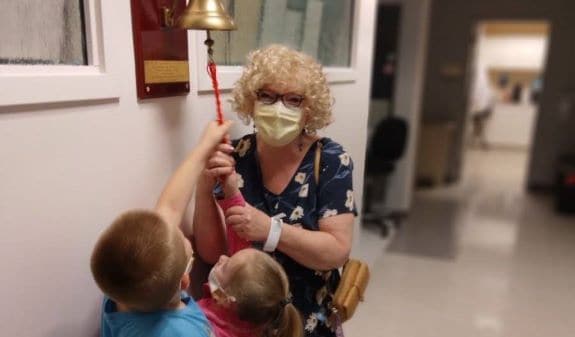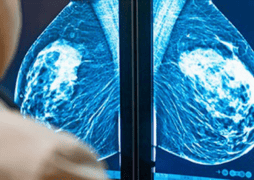Angelina Jolie can make headlines when she goes to buy milk. So it was no surprise that last May she was yet again front-page news. This time, though, it was not for her latest blockbuster movie or her relief work. It was much more personal – her choice to have preventive surgery to remove both of her breasts.
Ms. Jolie has a very high risk of breast cancer due to an inherited gene mutation. For her and other such women, this surgery – called prophylactic mastectomy – can greatly reduce the risk of developing breast cancer. It is one of a number of ways women like Ms. Jolie who have not been diagnosed with breast cancer, but have a very high risk may choose to manage this risk. Deciding which approach is best is a very personal choice.
Most women are not at high risk for breast cancer.
However, having certain inherited gene mutations can greatly increase the risk of breast cancer. The most common and most well recognized are mutations in the BRCA1and BRCA2 genes (BReast CAncer genes 1 and 2). BRCA1/2 mutations also increase the risk of ovarian cancer.
Less than one percent of the general population in the U.S. has a BRCA1/2 mutation.2 And, only about five to 10 percent of all breast cancers diagnosed in the U.S. are linked to inherited gene mutations or a strong family history of breast cancer.2
Women, such as Ms. Jolie, with a BRCA1 mutation have a 50 to 70 percent chance of developing breast cancer by age 70. Women with a BRCA2 mutation have a 40 to 60 percent chance.1 In comparison, an average woman has about an eight percent chance of developing breast cancer by age 70. 3 (An average woman’s lifetime risk up to age 85 is 12 percent).3
It is important to remember that having a BRCA1/2 mutation does not guarantee a woman will develop breast (or ovarian) cancer. Many women with these mutations will never have cancer.
Women at a very high risk of breast cancer have a number of options to manage their risk. For example, they can get breast cancer screening more often and starting at a younger age, to find cancer early if it does develop. Also, there are risk-lowering medications women can take, like tamoxifen and raloxifene. And, finally there is preventive surgery to remove both breasts (bilateral prophylactic mastectomy) and possibly the ovaries (prophylactic oophorectomy). Some women may even choose a combination of these options.
Bilateral prophylactic mastectomy is the surgical removal of both breasts to prevent breast cancer. If a woman chooses, the breasts can be reconstructed either during the surgery or sometime after. To provide better cosmetic results, methods can often be used that save the nipple and spare much of the skin of the breast. Women should talk with a plastic surgeon to discuss their reconstructive options, including the pros and cons of each.
Of all the options for managing breast cancer for women at very high risk, prophylactic mastectomy is the most effective at lowering risk. Studies show that it lowers risk by 90 percent or more.4 Risk does not completely drop to zero because a small amount of breast tissue will always remain after surgery. In premenopausal women, removing the ovaries can further reduce risk of both breast cancer and ovarian cancer.5 (Removing the ovaries impacts fertility, so for women at very high risk, this surgery is only recommended after women are sure they are finished having children.6) Women should discuss the benefits and drawbacks of these surgeries with their physician.
The most obvious benefit of bilateral prophylactic mastectomy is the drastic reduction in the risk of breast cancer. Most women report being satisfied with the decision to have the surgery.
Prophylactic mastectomy has many of the same short-term risks as other surgeries. There is always some danger with any type of general anesthesia. Pain and infection are also possibilities. Certain risks, though, are unique to mastectomy. Even with reconstruction, the physical changes to a woman’s body can have an emotional impact. Some women report being unhappy with the look of their reconstructed breasts, suffering from poor body image and feeling some level of loss of femininity or attractiveness. The loss of physical sensations in the breasts can also change sexual experiences. Support groups, mental health care providers (including sex therapists) and counselors can help women cope with the changes in their bodies and the feelings that come with these changes. Open communication with a partner is also important.
As a reminder, for anyone who has breast cancer related questions or concerns, Komen can help (see below).
In addition to preventive surgery, women can choose other options to manage or lower their breast cancer risk. These include:
More intensive screening: Women at very high risk of breast cancer begin getting mammograms and other screening tests earlier and more often than women at average risk. This more vigilant approach is designed to find any breast cancer that does develop early, so that it can be treated more effectively. This approach, however, does not lower the risk of getting breast cancer. Rather, screening tries to find breast cancer as early as possible.
Breast cancer screening for women at very high risk due to a BRCA1/2 mutation includes clinical breast exam, mammography and for those over 25, breast MRI.7
Risk-lowering medications: Tamoxifen and raloxifene are the two drugs FDA-approved for lowering breast cancer risk in women at high risk. These medications lower the risk of breast cancer in women at high risk by about 50 percent.8
Few studies have directly looked at the use of tamoxifen or raloxifene in women with BRCA1/2 mutations. However, the evidence suggests these medications can significantly lower risk, particularly for women with BRCA2 mutations.9
As with any medication, risk-lowering drugs can have side effects. Depending on the medication taken, these can include an increased risk of blood clots, stroke, osteoporosis or endometrial cancer.8
There is no single best approach to managing a high risk of breast cancer. It is a very personal decision that a woman should make together with her physician. Each of the approaches has its pros and cons (both physical and emotional). Screening in some ways is the easiest option since it doesn’t involve medication or surgery, but it doesn’t lower the risk of breast cancer. Risk-lowering medication can lower risk but can also have side effects. Prophylactic mastectomy most effectively lowers breast cancer risk, but is the most drastic and irreversible choice.
Which choice is best for a woman depends on how she prefers to approach her risk and the uncertainty of whether or not she’ll go on to develop cancer. This weighing of pros and cons most often reaches beyond the woman herself to include how her decision is also likely to impact her spouse or partner, family, friends and others who depend on her.
Some women who have breast cancer in one breast choose to have a preventive mastectomy to remove the opposite (contralateral) breast to prevent cancer from developing there. This is called contralateral prophylactic mastectomy. The number of women choosing this procedure is increasing.10, While a contralateral prophylactic mastectomy may lower the risk of developing cancer in the opposite breast, it’s unclear that it actually lengthens life for women with breast cancer.10 Contralateral prophylactic mastectomy is discouraged unless a woman has a BRCA1/2 mutation or other factors that greatly increase the risk of developing a second breast cancer.11-12
If you have a high risk of breast cancer, talk with your health care provider about the pros and cons of all the available options to manage or lower your risk, including bilateral prophylactic mastectomy. Remember to take the time to make the decisions that are right for you—don’t feel you need to rush. These decisions are highly personal and your provider can help you choose the method or methods that are right for you.
According to Komen Scholar, Dr. Funda Meric-Bernstam, Chair, Department of Investigational Cancer Therapeutics and Professor of Surgical Oncology at M.D. Anderson Cancer Center, “Many women overestimate their risk of breast cancer. It is important to remember that most breast cancers occur in women that do not have mutations in BRCA1/2. However as they say “Knowledge is power”- women with a family history of breast cancer at a young age or ovarian cancer should learn more about the cancer diagnosis of their family members and find out if they have undergone genetic counseling or testing. Women with a family history of breast or ovarian cancer should discuss this with their health care providers to get appropriate counseling and cancer screening.
For women with BRCA1/2 mutations, prophylactic mastectomy – also now known as “risk-reducing mastectomy”, is undoubtedly the most effective option to reduce the future risk of breast cancer. The cosmetic results have improved with the introduction of skin-sparing and nipple-sparing mastectomy approaches and immediate reconstruction. However, a reconstructed breast always looks and feels different than the original breast. This is an important decision that does not need to be rushed. Women with a BRCA1/2 mutation should be counseled about all of their risk management options including close surveillance, risk-lowering medications, prophylactic oophorectomy (removal of the ovaries) only and prophylactic mastectomy. Psychosocial counseling and discussions about body image and realistic expectations from reconstruction are important parts of personalizing the management plan for each woman.”
Learn more about BRCA1, BRCA2 and other inherited gene mutations.
Learn about testing for BRCA1 and BRCA2 mutations.
Learn more about contralateral prophylactic mastectomy.
Learn more about breast reconstruction.
Learn more about sexuality and intimacy after breast surgery.
Learn more about social support and find a list of support resources.
| Komen Support Resources |
| Our breast care helpline 1-877 GO KOMEN (1-877-465-6636) provides free, professional support services and help finding local support groups. Our trained and caring staff are available to you and your family Monday – Thursday 9 a.m. EST – 7 p.m. EST and Friday 9:00 a.m. – 6:00 p.m. EST. Our Message Boards offer online forums to share your thoughts or feelings about subjects related to breast cancer. Our Women at Higher Risk of Breast Cancer forum within the Message Boards offers women at higher risk a place to share their own unique experiences and challenges. |
Komen-funded researchers continue to work to improve our understanding of BRCA1/2 gene mutations as well as other gene mutations that may increase breast cancer risk. They are also working to develop improved methods of early detection and preventive treatments for women at high risk of breast cancer.
BRCA1/2 and other inherited gene mutations
Although BRCA1/2 are the most well-known genes linked to increased breast cancer risk, there are several less studied genes (and possibly many yet to be discovered) that may also be linked to risk. Komen has invested more than $35 million in research grants studying BRCA1/2 gene mutations and more than $21 million in grants focused on other inherited breast cancer gene mutations.
Learn more about Komen’s investment in BRCA1/2 research.
Prevention
Komen has invested nearly $47 million in research grants focused on the prevention of breast cancer, many of which are specifically focused on women at high risk.
Learn more about Komen’s investment in Prevention research.
Early Detection
Getting regular breast cancer screening is important for all women. It is especially important for women at high risk. Komen has invested more than $33 million in research grants that are developing better ways to find breast cancer early, when the chances of survival are highest.
Read more about Komen’s investment in Early Detection research.
More Than Research
In 2012, Komen provided support for the Society of Surgical Oncology annual meeting, which addressed the topic: “The Contralateral Prophylactic Mastectomy Dilemma – Trends, Benefits, Ethics?”
References
- Chen S, Parmigiani G. Meta-analysis of BRCA1 and BRCA2 penetrance. J Clin Oncol. 25(11):1329-33, 2007.
- National Cancer Institute. Genetics of breast and ovarian cancer (PDQ). http://www.cancer.gov/cancertopics/pdq/genetics/breast-and-ovarian/HealthProfessional/page2, 2013.
- American Cancer Society. Breast Cancer Facts & Figures, 2013-2014, 2013.
- Rebbeck TR, Friebel T, Lynch HT, et al. Bilateral prophylactic mastectomy reduces breast cancer risk in BRCA1 and BRCA2 mutation carriers: the PROSE Study Group. J Clin Oncol. 22(6):1055-62, 2004.
- Domchek SM, Friebel TM, Singer CF, et al. Association of risk-reducing surgery in BRCA1 or BRCA2 mutation carriers with cancer risk and mortality. JAMA. 304(9):967-75, 2010.
- National Comprehensive Cancer Network (NCCN). NCCN Clinical Practice Guidelines in Oncology: Genetic/familial high-risk assessment: Breast and ovarian, Version 4.2013. http://www.nccn.org, 2013.
- King MC, Wieand S, Hale K, et al. for the National Surgical Adjuvant Breast and Bowel Project. Tamoxifen and breast cancer incidence among women with inherited mutations in BRCA1 and BRCA2: National Surgical Adjuvant Breast and Bowel Project (NSABP-P1) Breast Cancer Prevention Trial. JAMA. 286(18):2251-6, 2001.
- Vogel VG, Costantino JP, Wickerham DL, et al. for the National Surgical Adjuvant Breast and Bowel Project. Update of the National Surgical Adjuvant Breast and Bowel Project Study of Tamoxifen and Raloxifene (STAR) P-2 Trial: Preventing breast cancer. Cancer Prev Res. 3(6):696-706, 2010.
- National Comprehensive Cancer Network (NCCN). NCCN Clinical Practice Guidelines in Oncology: Breast cancer screening and diagnosis, Version 1.2013. http://www.nccn.org, 2013.
- Tuttle TM, Habermann EB, Grund EH, Morris TJ, Virnig BA. Increasing use of contralateral prophylactic mastectomy for breast cancer patients: a trend toward more aggressive surgical treatment. J Clin Oncol. 25(33):5203-9, 2007.
- National Comprehensive Cancer Network. Updated NCCN guidelines for breast cancer discourages prophylactic mastectomy in women other than those at high risk. http://www.nccn.org/about/news/newsinfo.aspx?NewsID=226, 2009.
- National Comprehensive Cancer Network (NCCN). NCCN Clinical Practice Guidelines in Oncology: Breast cancer, Version 1.2014. http://www.nccn.org, 2014.



